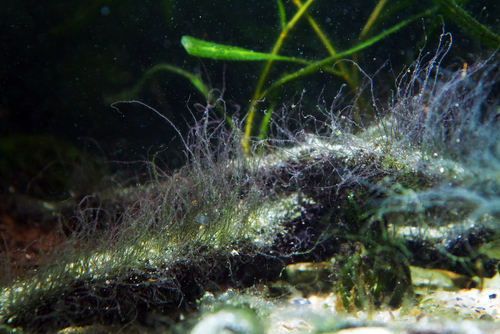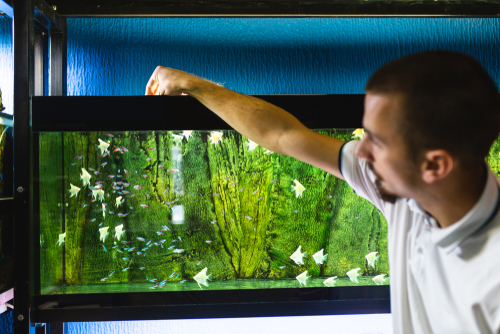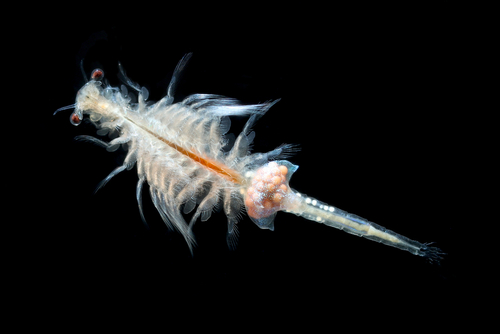Brine shrimp are tiny crustaceans that are commonly used as a food source for aquarium fish and other aquatic animals. These small creatures are easy to breed and care for, making them a popular choice for fish owners.
However, it is important to understand what to feed brine shrimp to ensure they stay healthy and provide the proper nutrition for your aquatic pets.
When it comes to feeding brine shrimp, there are a variety of options available. Many fish owners choose to feed their brine shrimp a commercial diet, which can be purchased at most pet stores.
These diets are typically high in protein and other nutrients that are important for the growth and development of aquatic animals. However, some owners prefer to feed their brine shrimp a more natural diet, such as algae or other small organisms.
Regardless of the type of diet you choose for your brine shrimp, it is important to monitor their health and nutrition.
Overfeeding can lead to poor water quality and other health issues, while underfeeding can stunt growth and lead to malnutrition. With proper care and attention, brine shrimp can be a valuable food source for your aquarium pets.
Contents
Understanding Brine Shrimp

Habitat
Brine shrimp are small crustaceans that are found in saltwater environments such as salt pans, salt lakes, and saltwater aquariums.
They are native to the Great Salt Lake in Utah, but are now found worldwide due to their use as a food source for fish and other invertebrates. Brine shrimp can tolerate a wide range of salinity levels, from 5 to 35 parts per thousand.
Lifespan
Brine shrimp have a short lifespan of only a few months. They go through several stages of development, starting as eggs and then hatching into nauplii.
As they grow, they shed their exoskeletons, a process known as molting. Adult brine shrimp can reproduce both sexually and asexually, and can lay up to 75 eggs per day.
Behavior
Brine shrimp are filter feeders, meaning they feed on small particles in the water. They use their legs to create currents that bring food particles towards their mouth.
They are also capable of swimming, using their legs and compound eyes to navigate through the water. Brine shrimp are social creatures and often form large groups.
Physical Attributes
Brine shrimp have a distinctive shape, with a long, slender body and a curved tail. They have compound eyes that allow them to see in all directions, and two pairs of antennae that they use for sensing their environment.
Brine shrimp also have a unique ability to enter a state of suspended animation, known as cryptobiosis, when conditions become unfavorable. In this state, they can survive for years without food or water.
Brine Shrimp Diet
Brine shrimp are small, aquatic crustaceans that are commonly used as a food source for fish and other aquatic animals.
In order to keep brine shrimp healthy and ensure they provide the necessary nutrients for the animals that consume them, it is important to provide a balanced diet. This section will cover the natural and supplemental diets of brine shrimp.
Natural Diet

Brine shrimp feed on a variety of natural foods in their natural habitat, including algae, phytoplankton, and microscopic planktonic algae.
These foods provide the necessary nutrients for brine shrimp to grow and develop. In captivity, it is important to provide brine shrimp with a similar diet to ensure they receive the necessary nutrients.
Supplemental Diet
In addition to their natural diet, brine shrimp can also be fed a variety of supplemental foods to enhance their nutritional value.
These foods include spirulina, fish meal, soybean powder, and flakes. Freeze-dried brine shrimp can also be used as a supplemental food source.
Spirulina is a type of blue-green algae that is high in protein and essential amino acids. Fish meal is a good source of protein and can also provide essential fatty acids.
Soybean powder is high in protein and can be used as a substitute for fish meal. Flakes can be used as a supplemental food source, but they should not be the sole source of food for brine shrimp.
Freeze-dried brine shrimp can be used as a supplemental food source, but they should not be the sole source of food for brine shrimp.
They are high in protein and can provide essential amino acids, but they lack the necessary nutrients found in live or fresh brine shrimp
Key Considerations for Feeding Brine Shrimp
When asking the question, ‘What do brine shrimp need to survive?’, one of the critical areas to focus on is their diet.
1. Nutritional Variability Across Life Stages
Understanding what to feed brine shrimp is crucial as their nutritional needs vary across different life stages.
Just like any other living organism, brine shrimp require a balanced diet that changes as they mature. Relying solely on a single type of brine shrimp food can lead to nutritional imbalances.
2. Water Quality, Temperature, and pH Dynamics
It’s not just about what brine shrimp food to provide; maintaining an optimal aquatic environment is equally essential for their survival.

Poor water quality, high ammonia levels, and unstable temperature or pH can all hinder the effective feeding of brine shrimp.
3. The Risks of Overfeeding
Overfeeding is one of the pitfalls when raising brine shrimp for fish food or any other purpose. Excess food degrades water quality, leading to stress and potential harm to the shrimp.
Breeding Brine Shrimp
Hatching Process
Breeding brine shrimp requires the hatching of brine shrimp eggs, which are also known as cysts. The hatching process involves placing the eggs in saltwater with the proper pH and temperature conditions.
The ideal temperature for hatching is around 80°F (27°C), and the pH should be between 7.5 and 8.5. It is also important to provide adequate aeration to ensure oxygen levels are sufficient.
The hatching process typically takes around 24-36 hours. During this time, the eggs will hatch into nauplii, which are the first stage of brine shrimp development.
Once the nauplii have hatched, they can be fed to fish or other aquatic animals.
When you’re focused on raising brine shrimp for fish food, ensuring a successful hatching process is crucial. Consider these guidelines:
- Sanitize hatching equipment regularly to prevent bacterial or fungal growth.
- Maintain a consistent water temperature for better hatching results.
- Always opt for high-quality, unexpired brine shrimp eggs for maximum hatch rates.
- Experiment with different egg-to-salt ratios for optimal hatching conditions.
Raising Brine Shrimp
After the nauplii have hatched, they can be raised to maturity. This involves providing them with the proper environment and food sources.
Brine shrimp require saltwater with a specific gravity of 1.018-1.022 and a pH of 8.0-8.5. They also need adequate aeration and a light source to support photosynthesis.
Brine shrimp can be fed a variety of foods, including yeast, spirulina, and commercial brine shrimp food. It is important to provide them with a balanced diet to ensure they reach maturity and reproduce successfully.
Breeding brine shrimp is a relatively simple process that can be done at home with the right equipment and knowledge.
By providing the proper environment and food sources, brine shrimp can be raised to maturity and used as a nutritious food source for fish and other aquatic animals.
Essential Equipment for Cultivating Brine Shrimp
If you’re wondering what do brine shrimp need to survive aside from food, it’s essential to consider the role of equipment in their cultivation:
Aeration Systems
Adequate aeration is a fundamental requirement when raising brine shrimp for fish food or research. A small air pump coupled with an air stone usually suffices for small tanks, while larger setups may require more robust pumps.
Specialized Salts
In terms of water quality, opting for synthetic marine or aquarium salt instead of common table salt can make a significant difference in the well-being of brine shrimp.
Lighting Solutions
A light source is a crucial part of what do brine shrimp need to survive, as it promotes algal growth—a primary food source for brine shrimp.
Brine Shrimp Care

Aquarium Setup
Before setting up an aquarium for brine shrimp, it is important to consider the tank size, tank mates, and tank requirements. Brine shrimp can be kept in small containers, but larger aquariums provide more space for the shrimp to swim and grow.
It is recommended to keep brine shrimp in a saltwater aquarium with a specific gravity of 1.020-1.025 and a temperature of 75-82°F (23-26°C). Adding an air stone and circulation can help maintain water quality and aeration.
Water Parameters
Maintaining proper water parameters is crucial for the health of brine shrimp. The water should be dechlorinated and the salinity should be checked using a hydrometer.
Brine shrimp are filter feeders, so the water should be free of debris and pollutants. It is important to regularly test the water for ammonia, nitrite, and nitrate levels and perform water changes as needed.
Feeding Brine Shrimp
Brine shrimp can be fed a variety of foods, including dehydrated brine shrimp cysts, live brine shrimp, and commercial brine shrimp food.
Live brine shrimp can be purchased at pet stores or hatched from dehydrated cysts. When feeding live brine shrimp, it is important to avoid overfeeding as excess food can lead to poor water quality.
It is recommended to feed brine shrimp small amounts of food multiple times a day.
Health and Nutrition

Nutritional Value
Brine shrimp are a nutritious food source for many aquatic animals, including fish, crustaceans, and mollusks. They are rich in protein, lipids, and essential nutrients such as vitamins and minerals.
Brine shrimp contain high levels of omega-3 and omega-6 fatty acids, which are important for maintaining a healthy immune system and promoting growth.
They also contain carotenoids, which give them their characteristic orange color and provide additional health benefits.
Health Benefits
In addition to their nutritional value, brine shrimp offer several health benefits. They contain beneficial bacteria that can help improve the digestive health of aquatic animals.
These bacteria can also help prevent the growth of harmful bacteria in the gut, reducing the risk of infections. Brine shrimp are also low in fat and cholesterol, making them a healthy food choice for animals that are prone to obesity or heart disease.
Brine Shrimp and the Environment
Natural Habitats
Brine shrimp are found in many different natural habitats, including oceans, salt pans, and inland saltwater lakes.
They are also commonly found in California and New Mexico, where they are harvested for use as fish food and in aquaculture. Brine shrimp are known for their ability to survive in extreme environments, including areas with high salinity and temperatures.
Impact on Ecosystem
Brine shrimp have a significant impact on the ecosystem in which they live. They are an important food source for many different species of fish and other aquatic animals.
In addition, they play a crucial role in the food chain by consuming algae and other microorganisms and transferring energy up the chain to larger predators.
However, excessive harvesting of brine shrimp can have negative impacts on the environment. Over-harvesting can lead to a decline in brine shrimp populations, which can have ripple effects throughout the ecosystem.
It is important to manage brine shrimp harvesting in a sustainable way to ensure the health of the ecosystem.
Frequently Asked Questions
What is the best food for hatching brine shrimp?
The best food for hatching brine shrimp is yeast. It is inexpensive and readily available at most grocery stores. Other options include spirulina powder or liquid fry food.
How often should I feed my brine shrimp?
Brine shrimp should be fed twice a day. However, it is important not to overfeed as this can lead to poor water quality and potential health problems.
What are some DIY options for feeding brine shrimp?
DIY options for feeding brine shrimp include using egg yolk, green water, or a mixture of yeast and water. However, it is important to note that these options may not provide all the necessary nutrients for the shrimp to thrive.
Can brine shrimp survive on egg yolk?
Brine shrimp can survive on egg yolk, but it is not recommended as a sole food source. Egg yolk lacks many of the necessary nutrients for the shrimp to grow and develop properly.
Is it necessary to feed fish brine shrimp?
It is not necessary to feed fish brine shrimp, but it can be a beneficial addition to their diet. Brine shrimp is high in protein and can help promote healthy growth and development in fish.
How long do brine shrimp live for?
Brine shrimp typically live for 4-6 weeks. However, their lifespan can vary depending on factors such as water quality and temperature.
Key Takeaways on What to Feed Brine Shrimp
- Brine shrimp are commonly used as a food source for aquarium fish and other aquatic animals.
- There are a variety of options available for feeding brine shrimp, including commercial diets and natural foods.
- Proper monitoring of brine shrimp health and nutrition is important for maintaining a healthy aquarium environment.
Check out these other related posts:

Veteran fish keeper and keen hobbyist with a serious case of MTS. My midlife crisis was the establishment of a fish room, much to my wife’s horror. Little does she know it could be worse!!


